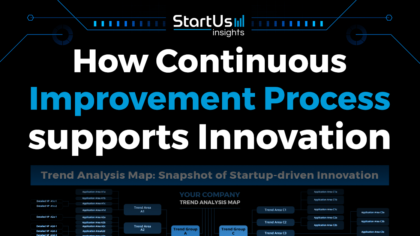Accelerate Productivity in 2025
Reignite Growth Despite the Global Slowdown
In the information economy, innovation is globally distributed. For companies to compete with other industry leaders and emerging startups, they need to constantly reinvent themselves. This is why the continuous improvement process (CIP) paradigm is on the rise. CIP identifies opportunities to streamline and optimize existing systems within a company. This allows companies to reduce waste, improve product quality, and achieve greater employee satisfaction. Moreover, it fuels corporate innovation by linking innovation with process improvement.
Benefits of Continuous Improvement Process
A continuous improvement process aims to take consistent measures to improve existing products and practices within an organization. Innovation, on the contrary, requires a leap by creating something new. Both are inextricably linked in the business strategies of many companies and complement each other.
1. Cost Savings
Continuous improvement identifies opportunities to eliminate waste, reduce defects during manufacturing, and improve quality while lowering material use. Moreover, it saves time by revealing and tackling operational inefficiencies. Consequently, savings in time and resources translate into cost savings, enabling further improvements.
2. Improved Knowledge Sharing
CIP outlines a mechanism for real-time knowledge sharing between not just business units within a company but also with external partners. This creates a system where knowledge is distributed and directly connected to innovation processes. As a result, better organizational learning results in an increase in operational efficiency, enabling teams to resolve bottlenecks fast.
3. Increased Product/Service Quality
Today, customer requirements can change in very short time spans. This requires companies to stay agile to quickly respond to these changes. CIP requires companies to closely monitor changing customer needs and market conditions. This allows companies to introduce continual improvements to product/service quality. In turn, this increases customer satisfaction and a firm’s competitiveness.
4. Shorter Feedback Loop
To meet ever-changing customer needs and battle competition, companies are pushing to shorten the time to market. CIP shortens the feedback loop as it integrates information from all stakeholders under a unified innovation agenda. This allows product teams to accelerate the time to value creation. For example, some companies implement real-time customer feedback in their product design.
5. Greater Employee Engagement
A continuous improvement process involves all employees within a company, either for feedback or in developing solutions. When employees feel that their feedback has an impact on the functioning of a company, they feel more valued. It creates a culture of intrapreneurship and co-innovation between business units. This way, CIP has a direct impact on employee engagement within a company.
Continuous Improvement and Innovation (CI&I)
CIP and innovation share a lot of features. Both of these involve the entire organization, lead to improvements in efficiency and productivity, and create opportunities to improve quality and increase value to customers. As such, companies often pursue them together under what is known as continuous improvement and innovation. Here are a few steps to implementing CI&I:
Incremental Innovation
A continuous improvement process gathers critical feedback from employees, customers, and clients. Developing tech-enabled solutions to resolve any bottlenecks often requires companies to seek innovation externally. On the other hand, data-driven startup scouting or competitor intelligence also provides insights into how other companies address similar issues. This is how continuous improvement, when performed with an eye for innovation, leads to continuous innovation as well. These incremental innovations are a low-risk, low-cost approach to raising a company’s bottom line.
Trend Landscaping
Your CI&I strategy will have some defined challenges and prospective solutions to them. However, it takes months to years to translate technical solutions into viable products. If you lose track of changing technology trends (and subsequent consumer trends), you might end up wasting time and resources. For example, you may be improving a feature that your customers may not care about or has a much better alternative later. This is why for successful CI&I, innovation managers need to receive feedback on changing trends as close to real-time as possible. Data-driven trend landscaping allows companies to identify emerging and latent trends earlier.
Gradual Product Rollouts
Driven mainly by software companies, there is a shift from major releases to gradual product rollouts. This forms the backbone of many CI&I strategies when product teams incorporate feedback from beta users. Beyond its role in innovation, gradual rollouts are both necessitated by and enable continuous improvement processes. It saves time and resources for failed products and improves profit margins for successful products.
Enable Data-driven Continuous Improvement and Innovation
Balancing continuous improvement with continuous innovation is critical for companies to stay competitive. Innovation intelligence allows you to identify technologies that optimize and derisk your processes. At StartUs Insights, we offer a range of services enabled by the StartUs Insights Discovery Platform covering over 2,5 million startups & scaleups globally. Some of our services that help you achieve CI&I include:
- Trend Scouting: Identify emerging and latent trends and developments that will advance your processes
- Technology Scouting: Reveal emerging technologies and learn how they can supercharge your innovation process
- Startup Scouting: Discover over 2,5 million startups & scaleups globally, scouting the right partners & saving you weeks of desk research

Startup-driven innovation is a rich source of solutions to drive continuous process improvement. Data-driven startup scouting allows you to tap this for your innovation goals.

![Future of Robotics: 12 Trends Powering the Next Wave [2025-2030]](https://www.startus-insights.com/wp-content/uploads/2025/06/Future-of-Robotics-SharedImg-StartUs-Insights-noresize-420x236.webp)
![Innovation During Recession: Key Data-Driven Strategies to Thrive [2025-2026]](https://www.startus-insights.com/wp-content/uploads/2025/06/Innovation-during-Recession-SharedImg-StartUs-Insights-noresize-420x236.webp)
![Business Resilience Planning: 10 Strategies & Technologies to Tackle the Current Market [2025-2026]](https://www.startus-insights.com/wp-content/uploads/2025/06/Business-Resilience-Planning-SharedImg-StartUs-Insights-noresize-420x236.webp)



